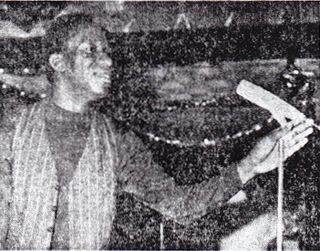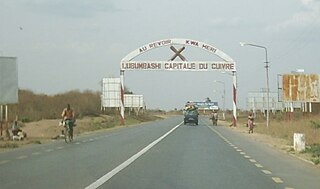
Laurent-Désiré Kabila usually known as Laurent Kabila, was a Congolese rebel and politician who served as the third President of the Democratic Republic of the Congo from 1997 until his assassination in 2001.

Congolese music is one of the most influential music forms of the African continent. Since the 1930s, Congolese musicians have had a huge impact on the African musical scene and elsewhere. Many contemporary genres of music, such as Kenyan Benga and Colombian Champeta, have been heavily influenced by Congolese music. In 2021, Congolese rumba joined other living traditions such as Jamaican reggae music and Cuban rumba on UNESCO's "intangible cultural heritage of humanity" list.

Gbadolite or Gbado-Lite is the capital of Nord-Ubangi Province in the Democratic Republic of the Congo. The town is located 12 kilometres (7.5 mi) south of the Ubangi River at the border to the Central African Republic and 1,150 kilometres (710 mi) northeast of the national capital Kinshasa. Gbadolite was the ancestral home and residence of Joseph-Désiré Mobutu, later self-styled as Mobutu Sese Seko where airport, colleges, malls, supermarkets and libraries were built by the President in a program of modernization. Gbadolite is where Mobutu led the summit that would produce the Gbadolite Declaration, a short lived ceasefire in the Angolan Civil War, in 1989.

The Alliance of Democratic Forces for the Liberation of Congo-Zaire, also known by the French acronym AFDL, was a coalition of Rwandan, Ugandan, Burundian, and Congolese dissidents, disgruntled minority groups, and nations that toppled Mobutu Sese Seko and brought Laurent-Désiré Kabila to power in the First Congo War. Although the group was successful in overthrowing Mobutu, the alliance fell apart after Kabila did not agree to be dictated by his foreign backers, Rwanda and Uganda, which marked the beginning of the Second Congo War in 1998.

Étienne Tshisekedi wa Mulumba was a Congolese politician and the leader of the Union for Democracy and Social Progress (UDPS), formerly the main opposition political party in the Democratic Republic of the Congo (DRC). A long-time opposition leader, he served as Prime Minister of the country on three brief occasions: in 1991, 1992–1993, and 1997. He was also the father of the current President, Felix Tshisekedi.

The Stade des Martyrs de la Pentecôte, or commonly referred to as the Stade des Martyrs, is the national stadium of the Democratic Republic of the Congo, located in the Kinshasa commune of the capital Kinshasa. With a seating capacity of 80,000, it is the largest stadium in the Democratic Republic of the Congo and the fourth-largest stadium in Africa. It serves as the home stadium for the Congolese football national team, Association Sportive Vita Club, and Daring Club Motema Pembe, making it the largest multifunctional venue in the country.

Pascal-Emmanuel Sinamoyi Tabu, better known as Tabu Ley Rochereau, was a leading African rumba singer-songwriter from the Democratic Republic of the Congo. He was the leader of Orchestre Afrisa International, as well as one of Africa's most influential vocalists and prolific songwriters. Along with guitarist Dr Nico Kasanda, Tabu Ley pioneered soukous and internationalised his music by fusing elements of Congolese folk music with Cuban, Caribbean and Latin American rumba. He has been described as "the Congolese personality who, along with Mobutu, marked Africa's 20th century history." He was dubbed "the African Elvis" by the Los Angeles Times. After the fall of the Mobutu regime, Tabu Ley also pursued a political career. His musical career ran parallel to the other great Congolese rhumba bandleader and rival Franco Luambo Makiadi who ran the band TPOK Jazz throughout the 1960s, 1970s and '80s.

Antoine Gizenga was a Congolese (DRC) politician who was the Prime Minister of the Democratic Republic of the Congo from 30 December 2006 to 10 October 2008. He was the Secretary-General of the Unified Lumumbist Party.

Nzanga Mobutu is a Congolese politician. A son of the long-time President Mobutu Sese Seko, he served in the government of the Democratic Republic of the Congo from 2007 to 2011, initially as Minister of State for Agriculture and subsequently as Deputy Prime Minister for Basic Social Needs and Deputy Prime Minister for Labor, Employment and Social Security. He received the fourth-highest number of votes in the 2006 presidential election. In 2007, Nzanga founded the Union of Mobutist Democrats as the successor to his father's Popular Movement of the Revolution and has led the party since.

Mass media in the Democratic Republic of the Congo are nationally and internationally state-owned and operated.
The following is a timeline of the history of the city of Kinshasa, Democratic Republic of the Congo.

The Palais de la Nation is the official residence and principal workplace of the President of the Democratic Republic of the Congo. It is strategically situated in Gombe, north of Kinshasa, adjacent to the course of the Congo River, and has held its role since 2001, following the assassination of Laurent-Désiré Kabila.
Faustin Munene is a Congolese military officer and politician known for his opposition to Mobutu Sese Seko, leader of Zaïre, and later President Joseph Kabila of the Democratic Republic of the Congo. He held a number of senior military posts under Laurent-Désiré Kabila after the fall of Mobutu, including commander of the Force Aérienne Congolaise, the DRC air force, and Deputy Minister of the Interior. Since 2010, he has been living in exile in the neighboring Republic of the Congo, having fled there since being accused by the DRC authorities of plotting a coup.

Pierre Yambuya Lotika Kibesi was a Zairean helicopter pilot, civil servant, and political refugee.

Dominique Sakombi Inongo was a Congolese politician and diplomat.

DR Congo–France are the bilateral diplomatic relations between the Democratic Republic of the Congo and France. Both nations are members of the Organisation internationale de la francophonie and the United Nations.
The Party of the People's Revolution was a clandestine communist party in the Democratic Republic of the Congo, later known as Zaire. The PDP was a Marxist political movement born in the convulsions of the Congolese crisis, being founded in 1967 in Fizi by Laurent-Désiré Kabila, who decades later would overthrow Mobutu and take control of the country.
The Palais de Marbre, also known as Marble Palace, is a palace and historic building in Kinshasa, Democratic Republic of the Congo, situated atop a hill in the Ngaliema Commune within the residential neighborhood of Ma Campagne, located a few miles from Mont-Fleury. The complex serves as a guest residence during specific official visits and is accessible to the general public, housing an exhibition that chronicles the history of Laurent-Désiré Kabila's assassination.

Formal diplomatic relations between Israel and the Democratic Republic of Congo have existed since 1962. Both countries are members of the United Nations. In 1973, like the majority of African countries that previously recognized Israel, Zaire decided to break its relations with Israel after the Yom Kippur War, but reestablished them, unlike other African countries, in the early 1980s.

The capture of Lubumbashi took place in April 1997, during the First Congo War in southern Zaire. The rebels of the Alliance des forces démocratiques pour la libération du Congo (AFDL) took the city of Lubumbashi from the Zairean armed forces (FAZ) loyal to President Mobutu Sese Seko.


















